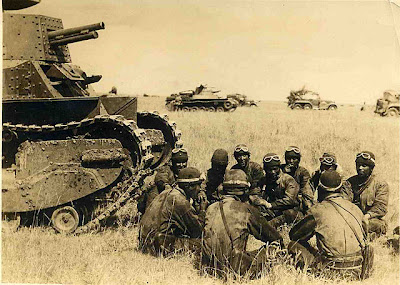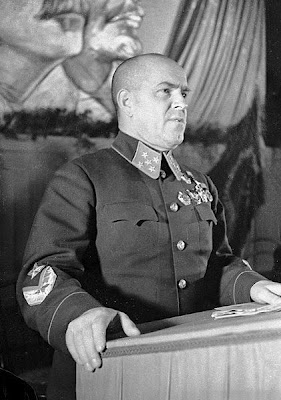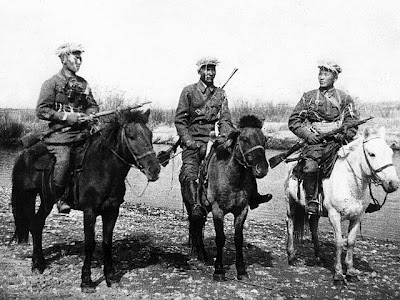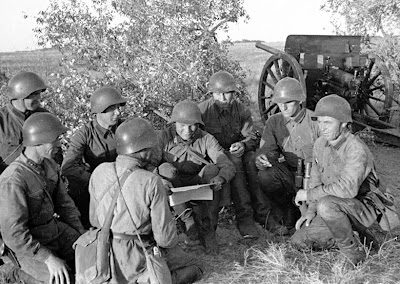Battle of Khalkhin Gol (I)
- By Peter Harmsen
- 13 September, 2013
- 22 Comments
 The 1939 Battle of Khalkhin Gol on the border of China and Mongolia pitted Japanese soldiers, such as the tank crew on the left, against Soviet troops. It was a pivotal event in the early war years, and unlike in the Finno-Soviet Winter War af few months later, the Soviet military side proved deadly efficient. Also unlike the war in Finland, the border clash between the Soviet Union and Japan has been neglected by western historians. What follows is the first of two installments of an article first carried by Warfare History Blog about this forgotten struggle.
The 1939 Battle of Khalkhin Gol on the border of China and Mongolia pitted Japanese soldiers, such as the tank crew on the left, against Soviet troops. It was a pivotal event in the early war years, and unlike in the Finno-Soviet Winter War af few months later, the Soviet military side proved deadly efficient. Also unlike the war in Finland, the border clash between the Soviet Union and Japan has been neglected by western historians. What follows is the first of two installments of an article first carried by Warfare History Blog about this forgotten struggle.
The Battle of Khalkhin Gol, known to the Japanese during the period as the Nomonhan Incident, is one of the most important conflicts of World War II that is often completely ignored or only a minor footnote in most concise or comprehensive popular history and academic studies of World War II. This border conflict fought on the edges between China and Mongolia developed into a major conflict during the Battle of Khalkhin Gol, dating back to previous border clashes during and after the Russian Civil War in the early 20’s. The conflict quickly escalated in the Spring of 1939 into a “small” war with a contained front that became a major theater of war by the time the Red Army claimed victory in September 1939, just as World War II began.
Critical to the later events of World War II itself, Khalkhin Gol was one of the most decisive and important conflicts fought during the last months of the prelude to World War. The actual military engagements of the battle fought from 11 May to September 1939, on the banks of the river, in the prairie-like fields and skies all around the Khalkhin River, effectively checked Imperial Japanese aggression and imperialist ambitions in Siberia and Mongolia for the duration of the war. This series of battles and skirmishes had combined casualties of perhaps in excess of 50,000 men was a decisive victory for the Red Army and their Mongolian allies. At the start of the war the Soviets were planning invasions of Poland and Finland, and the Baltic States, while the Japanese were still trying to suppress guerilla insurgency in occupied China and defeat the Revolutionary Nationalist Army under Chiang Kai-shek.

Georgy Zhukov
It was this reason that the Nomonhan Incident’s origins were from a Japanese view, just another euphemistic confrontation in their own greater diplomatic and military relationship with the nations of the Far East. The IJA’s invasion of Northern China in 1931 following the Mukden Incident, and the later occupation of Manchuria, leads to the start of the Second Sino-Japanese War in July 1937 which followed the Marco Polo Bridge Incident. A Red Army victory which seemed impossible in the minds of the Japanese command was achieved by the sharp tactical and logistical strategies of General Georgy Zhukov, the great hero and later Marshall of the Soviet Union, following his leadership and record of sucess (and survival) on the Eastern Front 1942-1945. Regardless the Khalkhin Gol-Nomonhan conflict remains important not just in acknowledging the importance of logistics, strategy, and tactics in relation to battlefield command (and strength of force), but in also understanding the shifting balance of power, both militarily and politically in Asia and the Far East in 1939.
On 5 June 1939, General Georgy Zhukov, later to become one of the greatest generals of all theatres in World War II, arrived in Mongolia to take command at the Khalkhin Gol front. Already an experienced and respected officer who had amazingly survived Stalin’s purges for the 30’s, Zhukov arrived during a dire time for the Soviets and their Mongolian allies. The Japanese maintained air superiority and the Russian lines of supply were rapidly diminishing under bombardments and close aerial support.
The Battle Begins
None of the commanding Russian officers had been to banks of the river where artillery and air duals persisted day and night and intelligence suggested a large-scale Japanese assault. General Zhukov assessed the situation and was able to secure the orders for the transfer of the necessary materials of war, mainly trucks, planes, fuel, and ammunition, to be rushed rapidly to this expanding theatre of operation on the border with occupied China. One can imagine General Zhukov being somewhat vexed by the tough task up ahead, crossing this bleak, barren, and seemingly endless landscape under skies controlled by the enemy who were hardened and well trained and led. Indeed Zhukov had to send his infantry and mechanized units some 400 miles past supply rail-heads into Chinese territory, across the river north towards the small village of Nomonhan, Manchukuo (occupied China), defended by a Japanese adversary renowned for discipline, courage, and history of complete victory in the previous conflicts in which it fought.

Mongolian People’s Revolutionary Army Cavalry 1939
The one advantage this landscape did hold was the fresh water of the Khalkhin (Halha) river itself, meaning the Red Army and its forces were supplied with a continual amount of drinking water throughout the battle. Regardless of material shortages on both sides the Japanese used a very high ratio of victories per pilot in the struggle for air superiority to gain an early advantage. On the ground IJA forces numbered between 30-45,000 men at their peak. These soldiers who fought almost to the last man were unable to overcome their immense logistical and supply handicap defending against a much larger and well supplied Soviet opponent who fielded an immense motorized force.Early bombing sorties ensured that the Soviets meanwhile would struggle to put operational planes in the field in June and early July. One example of this dominance fighter to fighter were the actions of 22 June, when 20 year old commander Kira Katsuaki and his 2nd Air squadron scored 19 kills against I-15’s and I-16’s in a little less than eight minutes during a daytime raid over Russian positions above the river.
On both sides throughout mid July 1939 artillery bombardments and aerial raids increased along the right, center, and left sides of the river banks as did sniper fire, skirmishing & night assaults/infiltration attempts increased as well. Coupled with the above mentioned weather conditions which bred disease namely dysentery and yellow fever, the infantry of the MPRA, Red Army, and IJA struggled to deal a knockout blow to one another into the last days of July in a war that was very much like the static trench warfare of 1915-1916.
The continued desperation of the Japanese hunkered in their defensives positions eventually aids in the successful Soviet bid to crush the remaining pockets of resistance despite shoddy command of the situation in the earliest weeks of the battle, which allowed for many Japanese infantry, engineering platoons, and armored brigades to move to the front. The Soviet-Mongolian armies at Khalkhin Gol were a coalition force led by the Red Army high command consisting of Soviet infantry, artillery, shock, mechanized, and aerial divisions, and Mongolian infantry, tank brigades, and cavalry scout divisions. The typical Soviet or Mongolian infantry unit consisted of rifleman carrying the standard Mosin-Nagant service rifle, accurate and dependable, with support from teams using the Degtyarev DP 7.62 light machinegun and the old and bulky but still effective 1910 Maxim heavy machine gun. The Mongolian cavalry divisions, namely the 6th, served with distinction throughout the conflict as scouts, shock troops, and rearguard communications runners.
Each infantry brigade and most armored brigades had supporting platoons of motorized rifleman, anti-tank companies, medical companies, field kitchens and field bakeries, and NKVD platoons. Always under the threat of a night assault or being overrun in an ambush, Soviet infantrymen and even officers often needed the draconian discipline and the authoritarian fear instilled in them by the NKVD commissars to deter any thought of retreating when they were attacked. Through the new found confidence given to the Russian-Mongolian infantrymen by the support of tanks and planes the reversal of the Red Army’s position in the battle had begun. When combined infantry-cavalry counter-offensives were launched after the early Red Army successes from 23-28 July the Kwantung was totally stunned. [4]
General Zhukov through the use of large scale simultaneous combined flanking operations shows the earliest example of the encirclement counter-offensive strategies that will destroy Nazi armies in 1943-1945. By early August the Soviets had increased armor usage on the front and tank brigades began rolling over IJA positions using their armor in succinct actions of advance, attack, and destroy.

Soviet artillery at Lake Khasan, 1938
The Japanese Imperial Army was a powerful entity leading into the Battle of Khalkhin Gol and its prestige had quickly risen in the 20’s and 30’s as the now pre-eminent, to-be-feared military power in Asia. From the time of the Samurai Rebellions of the 19th century and the first Wars with China,[5] to the defeat of the Russian Empire, the IJA and the Japanese Navy had proven themselves more than capable of beating their Asian and later Western adversaries. For better or worse, many IJA officers often codified their old philosophies and Samurai-esque fanaticism to preface their modern interpretations and practices of land, air, and sea warfare. Throughout the Second World War the IJA officer and enlisted soldier showed immense bravery and courage which led many of their regiments or platoons to die to the last man in the Pacific War from 1941-1945. Furthermore the well documented atrocities perpetrated by the IJA in China and in other occupied territories throughout 1939-1945 during the struggle for military and political control of Asia and the Far East, highlight the extreme consequences of this militant Japanese nationalism. (To be continued.)

 Copyright © 2025
Copyright © 2025
Leave a Reply